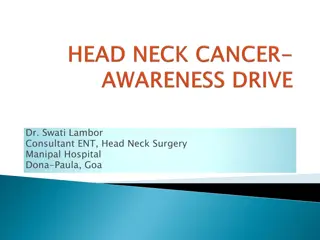Evaluation of Adherence to National Guidelines in Paediatric Patients for Surgical Management of OME
Retrospective review of clinical notes revealed that paediatric patients with OME and recurrent AOM generally met the criteria for surgery as per national guidelines (CG60). Compliance with guidelines was satisfactory, with approximately 81% adherence observed among clinicians. Cases of non-adherence were minimal, with only 1 out of 21 patients not meeting the criteria for surgery. Mitigating circumstances were present in some cases, such as patients with poor language development or family history of mastoiditis. Suggestions were made to improve adherence through better documentation processes.
Download Presentation

Please find below an Image/Link to download the presentation.
The content on the website is provided AS IS for your information and personal use only. It may not be sold, licensed, or shared on other websites without obtaining consent from the author.If you encounter any issues during the download, it is possible that the publisher has removed the file from their server.
You are allowed to download the files provided on this website for personal or commercial use, subject to the condition that they are used lawfully. All files are the property of their respective owners.
The content on the website is provided AS IS for your information and personal use only. It may not be sold, licensed, or shared on other websites without obtaining consent from the author.
E N D
Presentation Transcript
Objective To evaluate how well we are adhering to national guidelines (CG60: Surgical management of OME, Feb 2008); specifically do our paediatric patients meet the criteria for surgery
Local guidelines adapted from National NICE guideline In cases of OME 3/12 of watchful waiting 25db of conductive hearing loss in better ear Alternatives to surgery discussed 1. 2. 3. In cases of recurrent AOM 4 episodes in 6 months Alternatives to surgery discussed 1. 2.
Methods Retrospective review of the clinical notes at pre-admission by SHOs conducted from 20/09/2013 to 10/01/2013. Pre-existing proforma listing the NICE criteria completed for each child listed for bilateral insertion of grommets for bilateral OME. Completed forms then reviewed by ER and checked against clinical letters on clinical portal and adherence and non adherence recorded with details of latter cases obtained.
Results (1) In ~3/12 there were 21 cases of children having bilateral insertion of grommets Indications for bilateral grommet insertion 6% 9% 14% OME (15/21) Recurrent AOM (3/21) Both (2/21) 71% Other (1/21)
Results 2 Compliance of ENT unit with National guidelines: CG60 5% 9% 5% Adherence (17/21) Non-adherence (1/21) Mitigating circumstances (2/21) 81% Not documented (1/21)
Results 3 Breakdown of individual clinician adherence to guidelines 0 0 0 0 0 0 100% 1 2 80% 0 60% 9 1 3 5 40% 20% 0 0 0 0 0 0 0 0% SURG1 SURG2 SURG3 SURG4 SURG5 Adherence Non-adherence Mitigating circumstances Not documented
Results (4) 1 case of non adherence: Patient reported 6/12 hx of hearing loss and had a bilateral conductive hearing loss on audiometry and was listed for surgery on that first OPC appt; No 3/12 of watchful waiting. (?discussion of surg) 1st case with mitigating circumstances: Patient presented with a history of poor language development. No 3/12 of watchful waiting or formal audiometry. 2nd case with mitigating circumstances: Patient had normal audiogram, but family history of mastoiditis, recurrent episodes of AOM (not quantified)
Conclusions Low incidence of non adherence to guidelines (~5%) Would completing existing proforma at time of listing patients help improve this or needlessly generate more paper-work in what are already busy clinics? Observations made during audit: Documentation of discussion regarding alternatives to surgery not always clear. Quantification of cases of AOM often not stated.























